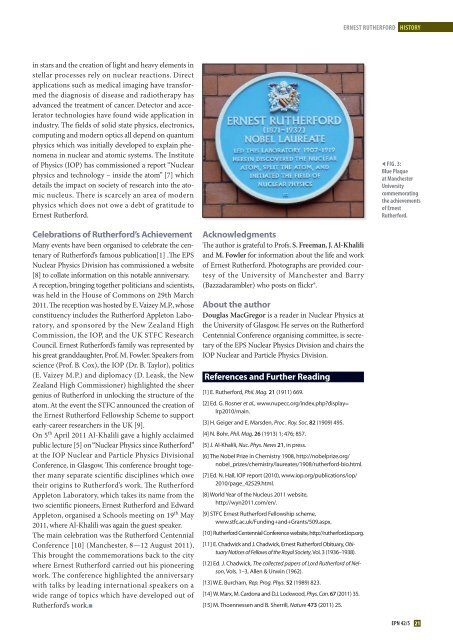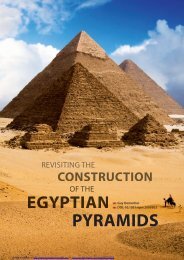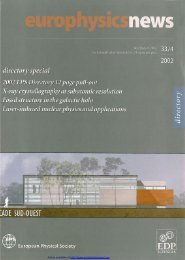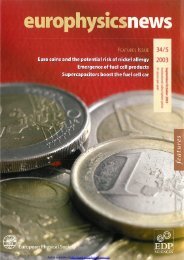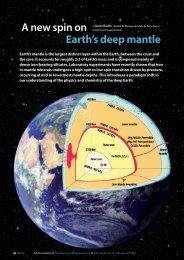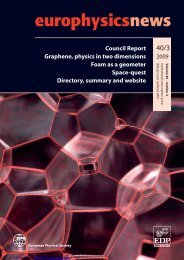PDF (11.37 MB) - Europhysics News
PDF (11.37 MB) - Europhysics News
PDF (11.37 MB) - Europhysics News
You also want an ePaper? Increase the reach of your titles
YUMPU automatically turns print PDFs into web optimized ePapers that Google loves.
in stars and the creation of light and heavy elements in<br />
stellar processes rely on nuclear reactions. Direct<br />
applications such as medical imaging have transformed<br />
the diagnosis of disease and radiotherapy has<br />
advanced the treatment of cancer. Detector and accelerator<br />
technologies have found wide application in<br />
industry. The fields of solid state physics, electronics,<br />
computing and modern optics all depend on quantum<br />
physics which was initially developed to explain phenomena<br />
in nuclear and atomic systems. The Institute<br />
of Physics (IOP) has commissioned a report “Nuclear<br />
physics and technology – inside the atom” [7] which<br />
details the impact on society of research into the atomic<br />
nucleus. There is scarcely an area of modern<br />
physics which does not owe a debt of gratitude to<br />
Ernest Rutherford.<br />
Celebrations of Rutherford’s Achievement<br />
Many events have been organised to celebrate the centenary<br />
of Rutherford’s famous publication[1] .�e EPS<br />
Nuclear Physics Division has commissioned a website<br />
[8] to collate information on this notable anniversary.<br />
A reception, bringing together politicians and scientists,<br />
was held in the House of Commons on 29th March<br />
2011. �e reception was hosted by E.Vaizey M.P., whose<br />
constituency includes the Rutherford Appleton Laboratory,<br />
and sponsored by the New Zealand High<br />
Commission, the IOP, and the UK STFC Research<br />
Council. Ernest Rutherford’s family was represented by<br />
his great granddaughter, Prof. M. Fowler. Speakers from<br />
science (Prof. B. Cox), the IOP (Dr. B. Taylor), politics<br />
(E. Vaizey M.P.) and diplomacy (D. Leask, the New<br />
Zealand High Commissioner) highlighted the sheer<br />
genius of Rutherford in unlocking the structure of the<br />
atom.At the event the STFC announced the creation of<br />
the Ernest Rutherford Fellowship Scheme to support<br />
early-career researchers in the UK [9].<br />
On 5 th April 2011 Al-Khalili gave a highly acclaimed<br />
public lecture [5] on“Nuclear Physics since Rutherford”<br />
at the IOP Nuclear and Particle Physics Divisional<br />
Conference, in Glasgow. �is conference brought together<br />
many separate scientific disciplines which owe<br />
their origins to Rutherford’s work. �e Rutherford<br />
Appleton Laboratory, which takes its name from the<br />
two scientific pioneers, Ernest Rutherford and Edward<br />
Appleton, organised a Schools meeting on 19 th May<br />
2011, where Al-Khalili was again the guest speaker.<br />
The main celebration was the Rutherford Centennial<br />
Conference [10] (Manchester, 8—12 August 2011).<br />
This brought the commemorations back to the city<br />
where Ernest Rutherford carried out his pioneering<br />
work. The conference highlighted the anniversary<br />
with talks by leading international speakers on a<br />
wide range of topics which have developed out of<br />
Rutherford’s work.■<br />
Acknowledgments<br />
�e author is grateful to Profs. S. Freeman, J. Al-Khalili<br />
and M. Fowler for information about the life and work<br />
of Ernest Rutherford. Photographs are provided courtesy<br />
of the University of Manchester and Barry<br />
(Bazzadarambler) who posts on flickr®.<br />
About the author<br />
Douglas MacGregor is a reader in Nuclear Physics at<br />
the University of Glasgow. He serves on the Rutherford<br />
Centennial Conference organising committee, is secretary<br />
of the EPS Nuclear Physics Division and chairs the<br />
IOP Nuclear and Particle Physics Division.<br />
References and Further Reading<br />
[1] E. Rutherford, Phil. Mag. 21 (1911) 669.<br />
[2] Ed. G. Rosner et al., www.nupecc.org/index.php?display=<br />
lrp2010/main.<br />
[3] H. Geiger and E. Marsden, Proc . Roy. Soc. 82 (1909) 495.<br />
[4] N. Bohr, Phil. Mag. 26 (1913) 1; 476; 857.<br />
[5] J. Al-Khalili, Nuc. Phys. <strong>News</strong> 21, in press.<br />
[6] The Nobel Prize in Chemistry 1908, http://nobelprize.org/<br />
nobel_prizes/chemistry/laureates/1908/rutherford-bio.html.<br />
[7] Ed. N. Hall, IOP report (2010), www.iop.org/publications/iop/<br />
2010/page_42529.html.<br />
[8] World Year of the Nucleus 2011 website,<br />
http://wyn2011.com/en/.<br />
[9] STFC Ernest Rutherford Fellowship scheme,<br />
www.stfc.ac.uk/Funding+and+Grants/509.aspx.<br />
[10] Rutherford Centennial Conference website, http://rutherford.iop.org.<br />
[11] E. Chadwick and J. Chadwick, Ernest Rutherford Obituary, Obituary<br />
Notices of Fellows of the Royal Society, Vol. 3 (1936–1938).<br />
[12] Ed. J. Chadwick, The collected papers of Lord Rutherford of Nelson,<br />
Vols. 1–3, Allen & Unwin (1962).<br />
[13] W.E. Burcham, Rep. Prog. Phys. 52 (1989) 823.<br />
[14] W. Marx, M. Cardona and D.J. Lockwood, Phys. Can. 67 (2011) 35.<br />
[15] M. Thoennessen and B. Sherrill, Nature 473 (2011) 25.<br />
erneST ruTHerford HiSTory<br />
� fig. 3:<br />
blue Plaque<br />
at manchester<br />
university<br />
commemorating<br />
the achievements<br />
of ernest<br />
rutherford.<br />
EPN 42/5 21


